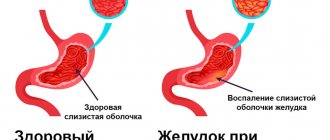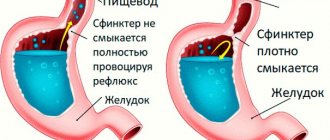Acute short-term complications of diabetes mellitus
Ketoacidosis
Diabetic ketoacidosis DKA is an acute insulin deficiency. If diagnosed late without treatment, it can lead to coma and death. It can develop in any type of diabetes, but is more common in type I.
Reasons for development
Without insulin, glucose does not enter cells. Instead, the body begins to break down fats as a source of energy. As a result, toxic ketone bodies are formed in excess. Within a few days they enter the blood and urine.
Early signs of pathological process:
- dry mouth, thirst, dry skin;
- high blood sugar level – 13 mmol/l and above;
- constant fatigue;
- frequent urination;
- weight loss.
When the level of ketone bodies in the body becomes critical, acute ketoacidosis develops. Its symptoms:
- abdominal pain, nausea and vomiting;
- a characteristic fruity smell from the mouth (usually felt by others, and not by the patient himself);
- high levels of ketone bodies in the blood and urine;
- drowsiness, lethargy;
- frequent, deep, sometimes difficult breathing;
- inability to concentrate;
- disturbance of consciousness.
From the moment vomiting appears, the pathology begins to progress rapidly to a life-threatening condition. If these symptoms appear, you should urgently call a doctor or an ambulance.
Therapeutic tactics for symptoms of DKA
First, blood glucose levels are measured. If it is 13 mmol/L or higher, measure the level of ketone bodies in the urine using test strips.
If this indicator is normal:
- short-acting or ultra-short-acting insulin is administered;
- Prescribe plenty of fluids - an average of 1 l/hour;
- monitor blood sugar levels and the level of ketone bodies in urine every 4-6 hours (the interval is determined by the doctor);
- treat concomitant pathologies (if any);
- limit physical activity to the minimum possible (it promotes more intense formation of ketone bodies).
If the level of ketone bodies is higher than normal, infusion therapy is indicated (carried out in a hospital or at home under the supervision of a doctor).
Hyperosmolar coma
Hyperosmolar diabetic coma is an extreme degree of metabolic disorder without ketoacidosis and background critical hyperglycemia (33 mmol/l and above). The body becomes dehydrated, and the levels of nitrogen, sodium and chlorine in the blood increase. With late diagnosis and treatment, mortality in hyperosmolar coma is 30-50%.
Causes of the condition:
- blood loss;
- a significant increase in the volume of urine excreted - due to the use of diuretics or other medications, dialysis, administration of saline solutions;
- diarrhea and vomiting;
- acute circulatory disorders;
- injuries and burns;
- severe infectious diseases.
Aggravating factors are increased blood glucose levels and the addition of concomitant diseases.
Signs of hyperosmolar coma
For 5-14 days before the attack, there is increased thirst and appetite, frequent and/or excessive urination, loss of strength and muscle weakness, up to the complete cessation of physical activity.
What to do
It is necessary to call an ambulance - treatment is carried out in the intensive care unit or intensive care unit. Treatment tactics include:
- rehydration - drip intravenous administration of medicinal solutions under the control of venous and blood pressure, the level of dehydration and the level of electrolytes in the blood plasma;
- insulin therapy.
Hypoglycemia
A decrease in blood glucose levels below 3.9 mmol/l. In a relatively mild form it is not dangerous: the patient himself can restore normal sugar levels. Severe forms of hypoglycemia damage brain cells and are life-threatening.
The condition occurs:
- due to insulin overdose;
- overdose of glucose-lowering drugs;
- increased insulin sensitivity due to exercise;
- local heating, massage, excessive depth of injection;
- increasing the interval between insulin and food;
- skipping meals;
- lack of carbohydrates;
- fasting;
- slowing down the evacuation of stomach contents;
- drinking alcohol.
Signs of hypoglycemia
Most patients feel an increase in hypoglycemia - they develop warning symptoms:
- shiver;
- heartbeat;
- pallor;
- fatigue;
- inability to concentrate;
- anxiety;
- sweating;
- increased appetite;
- sensory disturbances - goosebumps, numbness, etc.;
- nightmares.
As the sugar level decreases, dizziness, speech and vision disturbances, and convulsions are added. In a hypoglycemic coma, a person loses consciousness.
Treatment
In case of hypoglycemia, it is important to restore normal blood glucose levels. For relatively mild forms, it is enough to eat sugar, candy, a piece of chocolate, or honey. In severe forms, you need to call a doctor or an ambulance. Dextrose or glucan is administered intravenously to the patient.
Lactic acid coma
A sharp increase in the level of lactic acid in the blood.
Causes
Develops due to oxygen deficiency in tissues due to anemia, shock, carbon monoxide poisoning, alcohol or certain medications. It may occur against the background of kidney, liver, bone marrow, or bleeding diseases. The cause may also be myocardial infarction, serious illness or excessive physical activity.
Signs of lactic acidotic coma
The condition develops rapidly, within a few hours. The main manifestations are chest pain, diarrhea, noisy breathing, abdominal pain and vomiting, drowsiness or insomnia. Reflexes may disappear and motor activity may be impaired - muscle activity decreases or, on the contrary, involuntary movements appear. The patient's body temperature drops, urine ceases to be excreted, the contractility of the heart muscle decreases, blood clots form and even necrosis of the fingers.
Treatment
- Drip administration of a solution of soda, methylene blue or triamine, as well as small doses of insulin in 5% glucose.
- In severe cases, connection to an artificial kidney apparatus is indicated.
How to treat?
From all of the above, it is clear that patients can be bothered by such a dangerous condition as diarrhea in type 2 diabetes mellitus. Treatment of this pathology should be comprehensive, include drugs of different classifications and be aimed at correcting the following factors:
- normalization of glycemic levels,
- improvement of microflora,
- optimization of the speed of intestinal motility,
- restoration of normal water balance in the body,
- elimination of pathogenic bacteria and helminths.
To do this, first of all, you need to get recommendations from an endocrinologist regarding glucose-lowering therapy and insulin treatment.
Important! It is necessary to strictly follow the schedule for administering insulin and taking pills; in no case should you independently change the dosage of the prescribed drugs.
Doctors usually prescribe probiotics or eubiotics. As well as preparations with bismuth and diosmectite, which have an antibacterial effect while simultaneously absorbing bacterial toxins.
To stop diarrhea, medications containing plantain seeds are prescribed. They are able to bind water, which can make stool more dense. This greatly facilitates the act of defecation, especially for people who are tormented by constant urge with the release of small portions of feces.
Late chronic types of complications of diabetes mellitus
Diabetic micro- and macroangiopathy
Damage to the walls of large vessels and capillaries, accompanied by a violation of the functional state of the blood.
Causes
Occurs during decompensation of diabetes - with large daily fluctuations in the levels of glucose, proteins and fats. Aggravating factors of development are obesity, hypertension, smoking.
Signs
Due to metabolic disorders, the vessels of target organs are affected - the heart and limbs, the retina and the renal glomeruli. Because of this, the supply of oxygen to tissues is reduced, hormonal balance and metabolic processes are disrupted.
As a result:
- visual functions deteriorate;
- cardiovascular and renal failure develops;
- brain activity and nerve conduction are disrupted;
- Trophic ulcers develop on the arms and legs.
Without treatment, angiopathy progresses and can lead to complete blindness, amputations of limbs, heart attacks and intoxications, and deterioration of mental abilities.
Treatment
Diabetic angiopathy requires correction of the treatment regimen, as well as normalization of weight and blood pressure, and cessation of smoking. In addition, the doctor may prescribe drugs that strengthen the vascular wall - flavonoids, venotonics and phlebotonics.
Diabetic polyneuropathy
Damage to nerve endings up to complete ischemia - loss of sensitivity in the affected areas.
Causes
Develops with elevated blood sugar levels - when the drug or dose is chosen incorrectly.
Signs
Manifested by pain, loss of sensitivity, numbness, and night cramps. If large nerve fibers are damaged, loss of balance may occur.
Treatment
The goal of treatment is compensation of diabetes mellitus. Also indicated are drugs that improve neuromuscular conduction and symptomatic drugs for pain and cramps.
Diabetic encephalopathy
Damage to brain structures - mainly neurons and white matter. It develops slowly and imperceptibly, so it often appears in the later stages.
Causes
Typical metabolic disorders associated with long-term diabetes mellitus. In addition, risk factors are atherosclerosis, hypertension, and increased levels of C-peptide in the blood.
Signs
- deterioration of mental activity – mild to moderate (dementia rarely develops);
- emotional instability;
- increased anxiety;
- tendency to depression;
- chronic fatigue syndrome.
Treatment
Regular cognitive screenings and maintaining normal blood sugar levels. To improve brain activity, nootropic, antioxidant, antiplatelet and vasoactive drugs, vitamins B, E and alpha-lipoic acid are prescribed.
Diabetic foot syndrome
Purulent-necrotic and ulcerative lesions of the feet.
Causes
The condition occurs due to complex changes against the background of diabetic pathologies of blood vessels, nerves and tissues.
Signs
It manifests itself as increased trauma and infection of tissues, purulent-necrotic processes, which may require amputation.
Treatment
- control and correction of blood glucose levels;
- control and correction of blood pressure and cholesterol levels;
- professional foot care, monthly examinations by a podiatrist;
- unloading the foot;
- antiseptics and antibiotics for signs of wound infection;
- painkillers;
- drugs that improve nerve conduction;
- medications that improve blood flow.
When phlegmons and abscesses form, surgical opening is indicated. According to indications, angioplasty and stenting are performed. In extreme cases, gentle resections or amputations may be necessary.
Diabetic nephropathy
Damage to kidney structures due to diabetic metabolic disorders.
Causes
Elevated blood sugar levels cause increased pressure in the glomeruli. Because of this, the kidneys begin to excrete protein in the urine. Over time, this causes fibrosis of the kidney tissue. A factor that worsens the prognosis is concomitant atherosclerosis.
Signs
The disease remains asymptomatic for years and eventually leads to kidney failure. Its symptoms are a sharp decrease in daily urine volume and critical disruption of urinary processes.
Treatment
Selecting the correct treatment regimen allows you to prevent the process and even cause its reverse development in the early stages of the disease. Specific treatment is carried out with ACE inhibitors or angiotensin receptor blockers. Nephroprotectors are often prescribed; in severe cases - hemodialysis.
For elevated cholesterol levels, statins are indicated, and for hypertension, antihypertensive drugs are indicated. Diabetics with nephropathy are prescribed a diet with moderate restriction of animal protein. It is also important to normalize your weight and quit smoking.
Diabetic retinopathy
Damage to the vessels of the retina of the eyeballs.
Causes
Develops due to decompensation of diabetes. Due to increased blood glucose levels, the barrier properties of the retinal tissues decrease, the lumen of the vessels and the blood flow in them increase, the inner wall of the vessels is damaged, and the capillaries become permeable. Due to repeated hemorrhages, degeneration of the ocular structures develops.
Signs
Diabetic retinopathy is manifested by deterioration of vision up to complete blindness. Possible eye pain.
Treatment
Annual examination by an ophthalmologist specializing in diabetes, monitoring of sugar levels and dietary therapy. Animal fats are replaced with vegetable fats, fast carbohydrates are excluded, and lipotropic foods are introduced into the diet - fish, oatmeal and cottage cheese - to normalize cholesterol levels.
The menu also includes more fruits and vegetables (except starchy ones). Vitamin therapy and angioprotectors are often prescribed. At stages 3 and 4 of diabetic angiopathy, laser photocoagulation may be recommended.
Diabetic enteropathy as a cause of diarrhea
Due to an excess of unutilized glucose in the blood, a violation of the acid-base balance and water-salt balance occurs, which impedes the passage of nerve impulses along the fibers and, ultimately, leads to microdamage to the nerve plexuses in the intestinal wall. The intestinal tube expands unevenly in different areas. Spasmodic areas alternate with widened loops. Along with this, the intensity of peristaltic waves decreases significantly, and due to disturbances in ion exchange, water leaves the tissues into the intestinal lumen. If diabetic enteropathy is not stopped, serious consequences associated with dehydration and nephropathy may occur.
Prevention of diabetes complications:
- correct treatment regimen - correctly selected drug and dose (sugar levels are always normal);
- fulfilling all doctor's orders;
- weight normalization;
- normal motor activity;
- sufficient sleep;
- balanced diet;
- regular examinations by an endocrinologist, vascular surgeon, neurologist, ophthalmologist, podologist, nephrologist.
Professional medical supervision, patient self-discipline and a healthy lifestyle can reduce diabetes complications to a minimum or even prevent them altogether.
Treatment with folk remedies
In the non-drug treatment of diarrhea in diabetes, the most important thing is to replenish the lack of fluid. The main volume should be non-carbonated clean water. You need to follow a low-calorie diet, which consists mainly of low-fat broths, natural fruit drinks, juices, dried fruit compotes, grain porridges and steamed vegetables. Traditional medicine methods play an important role. The most popular recipes are:
- squeeze the juice of two ripe oranges and add one liter of water to it, mix well and drink one glass of the drink three times a day. This drink is rich in ascorbic acid and has a powerful tonic effect,
- take the green parts of chicory and boil in two liters of water for 10 minutes. After this, remove from heat and leave for another half hour. Before use, strain and add honey to taste. Drink 100 milliliters twice a day twenty minutes before meals,
- Pour 50 grams of dried rose hips with 200 milliliters of boiling water. Close the container tightly with a lid and leave the drink in a dark, dry place for 6 hours. Take 50 ml orally twice a day before meals. Eating rose hips, as healers write in many articles, helps cope with inflammation, facilitates the flow of bile and improves digestion. This plant has an astringent effect, so its use speeds up recovery.
Untreated diarrhea can have serious health consequences. Therefore, it is very important for diabetics to consult a doctor in a timely manner and begin to treat this condition to prevent complications of the pathology.
Video on the topic of the article:
What medications should always be on hand
For diabetics, an important condition is the speed of first aid; therefore, certain medicinal items should always be available at home.
We are talking about items for monitoring sugar levels - a glucometer, test strips, lancets, powders containing electrolytes. The latter are used for dehydration, for example, Regidron. You cannot do without drugs to stabilize the functioning of the gastrointestinal tract - Mezim, Linex, No-Shpa and compounds that normalize glucose levels. All this will allow the diabetic to maintain maximum vital activity and avoid the development of complications.
What to do if diarrhea appears
Abdominal upset is common in diabetics. It is quite possible that it is temporary and will pass without the use of special therapy. You need to analyze your diet, general health (whether there are additional symptoms of illness) and only then take action.
If there have been no more than 3-4 trips to the toilet, other than diarrhea there are no problems with your health, including abdominal pain, then you can take adsorbents. They work as a kind of body cleanser, absorb harmful substances into their surfaces and remove them out during urination or defecation. Most likely, a mild digestive disorder has occurred and to help the body you need to drink more water and exclude heavy foods for a day.
Vomiting due to hyperglycemia
Nausea and vomiting with elevated sugar levels indicate the development of diabetic precoma. Precoma develops when the glucometer reading exceeds 19. The patient also experiences the following symptoms:
- apathy and indifference to everything that happens;
- dyspnea;
- visual disturbances;
- the appearance of pain in the heart area;
- cold extremities;
- lips are dry and take on a bluish tint;
- the skin is cracking;
- A brown coating appears on the tongue.
Frequent vomiting with hyperglycemia poses a great danger to humans. The fact is that in this condition a person develops excessive urination, which leads to loss of fluid. Vomiting worsens dehydration.
Irritable bowel syndrome and diarrhea, diarrhea
This disease does not change the results of blood and stool tests used to diagnose diabetes. Intestinal irritation is indicated by abdominal pain with loose stools and diarrhea, in which the patient does not have infectious irritants, helminths, tumors or other causes of obstruction.
The first signs of diabetes. The gastrointestinal tract can signal the progression of diabetes in three ways: diarrhea, constipation, or their alternation. The most common occurrence is diarrhea and diarrhea. The disease makes itself felt through the urge to defecate, appearing immediately after eating. This mainly happens in the morning, but the situation can repeat several times throughout the day. In this case, loose stools also occur under the influence of severe stress, fear and other emotionally stressful situations. The patient experiences bloating and pain in the navel area. These symptoms provoke the urge to defecate, and then subside.










